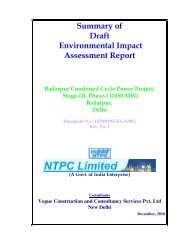proposed integrated complex for delhi judicial academy
proposed integrated complex for delhi judicial academy
proposed integrated complex for delhi judicial academy
You also want an ePaper? Increase the reach of your titles
YUMPU automatically turns print PDFs into web optimized ePapers that Google loves.
Rapid Environmental Impact Assessment (REIA) Study <strong>for</strong> Proposed Integrated Complex <strong>for</strong> Delhi Judicial Academy,<br />
National Law School, and National Institute <strong>for</strong> Mediation & Conciliation at Dwarka, New Delhi<br />
The figure shows the annual average of RSPM levels over the city. It is clear that RSPM<br />
levels have reduced to 21.4 % in the year 2001 and remained almost constant in the year 2002 as<br />
compared to year 2000. The increase could be due to adverse meteorological conditions in 2002.<br />
Carbon Monoxide (CO)<br />
The annual average CO levels as shown in the figure indicate constant reduction of CO levels at<br />
ITO intersection. The observed concentration of CO came down from 4183 µg/m 3 in Year 2001 to<br />
3258 µg/ m 3 in Year 2002. This could be attributed to the stringent vehicular emission norms, fuel<br />
quality up-gradation and development of better engines. Though the annual average levels of<br />
Carbon Monoxide continue to be above the danger mark of 2,000 µg / m 3 , there has been a gradual<br />
decline.<br />
4.5.2 Ambient Air Quality Survey<br />
The existing ambient air quality in the core zone (local and immediate vicinity) of the <strong>proposed</strong><br />
project site has been assessed during summer 2006 through a network of four ambient air quality<br />
stations. The prime objectives were to establish existing local background levels and baseline air<br />
pollution status. The ambient air quality monitoring network has been designed keeping in view the<br />
available predominant wind direction and wind speed in the project area. One station was kept at<br />
the centre and the other three at about 120 o direction apart. The sources of air pollution in the<br />
project area are mainly vehicular traffic, construction activities, and general human activities.<br />
The following points were also taken into consideration in designing the network of sampling<br />
stations:<br />
• Locations with increasing mixed residential and commercial development within the study<br />
area.<br />
• Locations near Schools, hospitals and other sensitive areas within the study area.<br />
• Locations which are representative of land-use categories.<br />
• Representation of cross sectional distribution in downward direction.<br />
• Locations where the baseline ambient air quality are established such that it can be<br />
resurveyed in the future to monitor changes in the ambient environment.<br />
• Locations within the project area with the least interference of anthropological activities.<br />
63
















